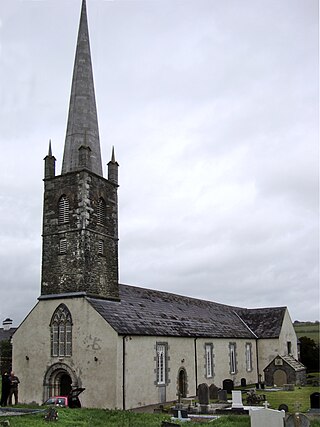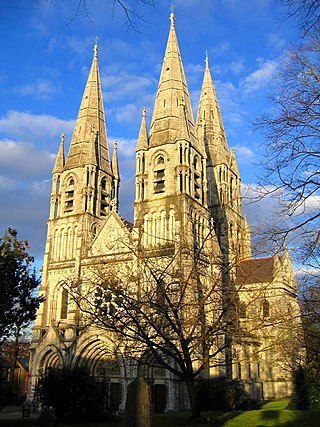Related Research Articles

Rosscarbery is a village and census town in County Cork, Ireland. The village is on a shallow estuary, which opens onto Rosscarbery Bay. Rosscarbery is in the Cork South-West constituency, which has three seats.
Saint Carthage the Elder was an Irish bishop and abbot in the sixth century. His feast day is 5 March.

Kilian, also spelled Cillian or Killian, was an Irish missionary bishop and the Apostle of Franconia, where he began his labours in the latter half of the 7th century. His feast day is 8 July.

Ciarán of Saigir, also known as Ciarán mac Luaigne or Saint Kieran, was one of the Twelve Apostles of Ireland and is considered the first saint to have been born in Ireland, although the legend that he preceded Saint Patrick is questionable. Ciarán was bishop of Saighir (Seir-Kieran) and remains the patron saint of its successor, the diocese of Ossory.

Emly or Emlybeg is a village in County Tipperary, Ireland. It is a civil parish in the historical barony of Clanwilliam. It is also an Ecclesiastical parish in the Roman Catholic Archdiocese of Cashel and Emly.
The School of Ross was a monastic institution located in what is now called Rosscarbery, County Cork, Ireland, but formerly Ross-Ailithir, from the large number of monks and students who "flocked" to it from all over Europe.
The Diocese of Ross was a separate diocese situated in south-west Ireland. Following the Reformation, there were two dioceses. In the Church of Ireland, the diocese is now part of the Diocese of Cork, Cloyne and Ross. In the Roman Catholic Church, it is part of the Diocese of Cork and Ross. In the 19th century, an exclave of the diocese existed around that part of the Beara peninsula in County Cork including the area around Glengariff though not as far east as Bantry. The main diocesan territory was centred on the towns of Baltimore, Skibbereen, Rosscarbery and Clonakilty which lie along the modern national road N71.
Thomas O'Herlahy was the Catholic Bishop of Ross, Ireland (Rosscarbery).

The Bishop of Ross was a separate episcopal title which took its name after the town of Rosscarbery in County Cork, Ireland. The title is now united with other bishoprics. In the Church of Ireland it is held by the Bishop of Cork, Cloyne and Ross, and in the Roman Catholic Church it is held by the Bishop of Cork and Ross.
The Bishop of Cork and Ross is an episcopal title which takes its name after the city of Cork and the County Cork town of Rosscarbery in the Republic of Ireland. The combined title was first used by the Church of Ireland from 1638 to 1660 and again from 1679 to 1835. At present the title is being used by the Roman Catholic Church.

The Diocese of Cork, Cloyne and Ross, also referred to as the United Diocese of Cork, Cloyne and Ross, is a diocese in the Church of Ireland. The diocese is in the ecclesiastical province of Dublin. It is the see of the Bishop of Cork, Cloyne and Ross, the result of a combination of the bishoprics of Cork and Cloyne and Ross in 1583, the separation of Cork and Ross and Cloyne in 1660, and the re-combination of Cork and Ross and Cloyne in 1835.

The Cathedral Church of St. Fachtna, also known as the Cathedral Church of St Faughan,Ross Cathedral, and Rosscarbery Cathedral, is a cathedral of the Church of Ireland in Rosscarbery, County Cork in Ireland. Located in the ecclesiastical province of Dublin, it is the smallest cathedral in Ireland. Having once been the mother church of the Diocese of Ross, it is now one of three Anglican cathedrals in the United Dioceses of Cork, Cloyne and Ross, alongside Saint Fin Barre's Cathedral and Cloyne Cathedral.
Mervyn Archdall was an Irish antiquary and clergyman of the Church of Ireland.
Airbertach mac Cosse was an Irish poet, lector and later superior of the monastery of Ros Ailithir, on the coast of south-west County Cork. Rofessa i curp Domuin Dúir, a poem on the geography of the world, is ascribed to him in both the Rawlinson B 502 and the Book of Leinster.

Mo Chutu mac Fínaill, also known as Mochuda, Carthach or Carthach the Younger, was abbot of Rahan, County Offaly, and subsequently, founder and first abbot of Lismore, County Waterford. The saint's Life has come down in several Irish and Latin recensions, which appear to derive from a Latin original written in the 11th or 12th century.

Mobhí Clárainech was an Irish early monastic saint, counted as one of the Twelve Apostles of Ireland. He was the abbot of a monastery in Glasnevin, where he was a teacher of Columba, Canice, Comgall, and Ciarán.

Saint Mochoemoc was an early Irish abbot, later considered to have been a saint. He was a nephew of Saint Íte of Killeedy, who raised him. He became a monk in Bangor Abbey under the abbot Saint Comgall of Bangor. He was the founding abbot of Liath-Mochoemoc (Liathmore) monastery. His feast day is 13 March.
References
- 1 2 ""Saintly People", Diocese of Cork and Ross". Archived from the original on 16 June 2013. Retrieved 12 May 2013.
- ↑ O'Halloran, W. Early Irish History and Antiquities and the History of West Cork, 1916
- 1 2 3 4 Mervyn Archdall, Monasticum Hibernicum; or an History of the Abbies, Priories, and other Religious Houses in Ireland (Dublin, 1786), vol. 1, pp. 142–144; reproduced also in Irish Ecclesiastical Record, Vol VII, 1871, pp. 485-488
- ↑ Stephen & Lee 1894, p. 89.
- ↑ Óengus of Tallaght (1905). Stokes, Whitley (ed.). The Martyrology of Oengus the Culdee. Henry Bradshaw Society. Vol. 29. London. p. 89.